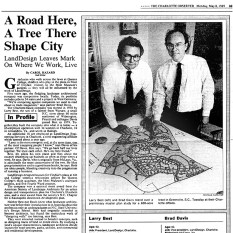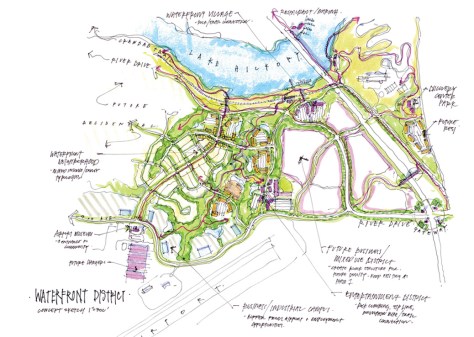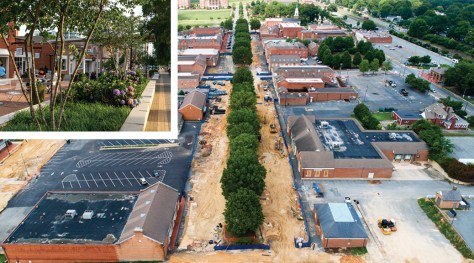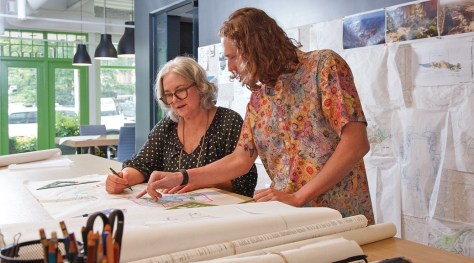A humble attitude brought the Charlotte firm work for three decades. Pulling out of the recession called for bolder moves.
By Bradford McKee
In 2014, six years after the Great Recession showed up at LandDesign’s doorsteps, Rhett Crocker, ASLA, was looking to lead the firm out of survival mode. Crocker had just become the firm’s fifth president. He wanted to attract new kinds of clients—national ones with big names—but few seemed to recognize the firm or its work. Even a longtime client, who assumed the firm did work only in Charlotte, North Carolina, where the firm is based, expressed surprise at seeing a major project LandDesign had done “in China or the Caribbean or someplace,” Crocker recalls. “He had no idea of the depth of what we do.”
Before Crocker took the helm, the firm had endured a prolonged period of upsets. In 2007, LandDesign had one of its busiest years. It had grown to 300 people across seven offices, offering a specialized pairing of landscape architecture and civil engineering. Then came the shocks. Brad Davis, the firm’s president at the time, died of cancer. Two weeks later, Dave Taylor, a partner in the Tampa office, died unexpectedly. The firm was still grieving when the global financial crisis began in 2008. As the recession set in, work began to vaporize. In 2009, LandDesign had to slash everything possible for the sake of survival. The head count fell to 63 people.

LandDesign’s original partners: the founder, Larry Best (left), and Brad Davis in 1989. Photo courtesy LandDesign.

Brad Davis (left) with Peter Crowley, LandDesign’s third recruit. Photo courtesy LandDesign.

Rhett Crocker, now LandDesign’s president, and Richard Petersheim, a partner, in 2009. Photo courtesy LandDesign.

Gabriela Cañamar Clark, ASLA, a partner, with Peter Crowley. Photo courtesy LandDesign.

Brad Davis, Peter Crowley, and an unidentified colleague, with Larry Best at far right. Photo Courtesy Landdesign
A fair number of design firms collapsed during the Great Recession. LandDesign reduced the number of offices to three and conducted a series of layoffs that included staff with ownership shares. The remaining partners stopped paying themselves and instead plunged their capital into the firm to keep it alive.
What would be considered heroic in another firm was, at LandDesign, encoded in the ethos of Larry Best, who founded the firm in his Charlotte home in 1978. When launching the firm, Best looked for partners who prioritized the interests of the enterprise over themselves. “He had the foresight very early on that the only way he was going to grow this thing is if he had partners,” Crocker says. “And the only way to have partners was to allow them to afford to buy into the business without second-mortgaging their house.”
 LandDesign’s Charlotte, North Carolina, office remains its base among offices in Orlando, Dallas, Denver, and Washington, D.C. Image by Studio 323, Inc., photographs by HughTurbyfill.
LandDesign’s Charlotte, North Carolina, office remains its base among offices in Orlando, Dallas, Denver, and Washington, D.C. Image by Studio 323, Inc., photographs by HughTurbyfill.
Best’s approach meant there was always a ready bench of leaders poised to take the reins. Succeeding Davis as president was Peter Crowley, who was the firm’s third recruit and is credited with having steadied the staff through the shock of their personal losses and the first months of the world’s—and the firm’s—financial catastrophe. Crowley then handed the reins to another longtime partner, Dale Stewart, who together with the chief operating officer Ray Waugh tightened LandDesign’s belt to ensure the firm could survive the recession.
The firm’s austerity gave it a stronger financial footing. When Crocker became president in 2014, he put more entrepreneurial focus on growth. A key to his strategy was making the firm more recognizable to potential clients. Ashley Clark, a principal in charge of strategic development and communications, says that Crocker recognized that although the firm produced excellent work, it lacked visibility. The effort paid off as the firm has steadily grown during a decade-plus under Crocker’s leadership. By 2024, the firm had rebuilt its staff to 270 people in five U.S. offices and expanded its portfolio of projects in large-scale land planning, landscape architecture, urban design, and, notably, civil engineering. Mainly, Crocker says, the firm figured out how to market itself.
Larry Best founded LandDesign for longevity with a focus on ownership succession.
Before Clark built a strong marketing team, LandDesign was content “to be behind the scenes and do our work and be happy,” Crocker says. “And we still do that.” Yet Crocker has pushed the firm to be more vocal about its experience and accomplishments. “We still try to stay very humble in the industry,” he says. “But we also realize that we need to be more loud and proud. And we need to tell people what we’re working on.”
Today, LandDesign has accumulated a telling list of honors and achievements that reflect its wider scope. Among the most recent is the 2024 Landscape Architecture Firm Award granted by ASLA’s Board of Trustees for its distinguished contributions to the field of landscape architecture. LandDesign’s strengthened and diversified client list now includes some of the best-known names in the development industry: Disney, Howard Hughes Holdings, Comstock, Hillwood, and Universal Entertainment, among others. It has also forged collaborations with big global architecture firms such as HKS, Gensler, HOK, and Populous, giving LandDesign access to new markets: hospitality, sports and entertainment, and large-scale mixed-use development, including a comprehensive retrofit of Tysons, formerly Tysons Corner, a business district built for the automobile age in Northern Virginia outside Washington, D.C.
 A working sketch of a public realm proposal for the lakefront in Hickory, North Carolina, 2019. Illustration © LandDesign.
A working sketch of a public realm proposal for the lakefront in Hickory, North Carolina, 2019. Illustration © LandDesign.
The strengths LandDesign called on to rebound in the mid-2010s owe much to the firm’s foundational philosophy under Best. He regarded succession planning as his most important job after winning and executing design work. Some principals build this realization into their long-range scenarios, while others pay little thought to ownership transition before they die, leaving spouses or children to unload the plotter, cancel the lease, and take the nameplates off the doors. Larry Best equipped LandDesign to survive any individual; no one’s name was on the door.
Best’s focus on succession benefited both the firm and Best, who, Crocker says, reached his retirement in his mid-50s in 2002, pleased with what the firm had brought him personally. To keep ownership shares spread evenly, individual ownership is capped at 10 percent. “So you don’t have anyone that’s too big to take down if they retired or moved on. It’s a very generous and balanced system,” he says.
Coming out of the recession, Crocker was a natural choice to be its next president. He had a love of making big master plans, which kept him roving all around the firm. His colleagues found his energy for new ideas infectious. Crucially, Crocker is quite comfortable expanding client relationships. While local relationships and word-of-mouth connections helped lead the firm from one client to another in its first three decades, LandDesign was less adept at making new friends on the street, Clark says. “It was all relationships, 100 percent to that point, but we were starting to get the opportunity to go up against known firms, and we’d lose,” she says, because no one knew who they were. Clark had previously worked at the firm and rejoined in 2014 to help Crocker and the partners develop new business.
 LandDesign’s ongoing engagement with Kannapolis has included extensive infrastructure upgrades to West Avenue, completed in 2019. Photo © LandDesign.
LandDesign’s ongoing engagement with Kannapolis has included extensive infrastructure upgrades to West Avenue, completed in 2019. Photo © LandDesign.
Crocker thought they needed to diversify LandDesign’s work as a hedge against market vulnerability. He also believed the firm was underestimating itself, he recalls. Soon after he became president, he says, “There was a public RFP for a project not too far from here. Everybody in the room told me why we can’t do it. We can’t compete. We don’t have the portfolio.” Crocker says that he was fuming. “Maybe we lose, but you don’t know if you don’t try. And a lot of it was just marketing material. We had the portfolio. We just didn’t have the documentation. So we had to ramp that up.”
The firm’s leadership mapped out a strategic plan for what they wanted to accomplish, in effect reintroducing their own firm to themselves before rolling it out to a broader range of prospective clients. The story to tell was that LandDesign had been in business for 30 years with much to show for capabilities that its competition couldn’t match.
For most of that time, LandDesign practiced civil engineering as a close companion to its landscape architecture and planning services. The tandem approach provided early clash detection to avert site conflicts that might otherwise upset projects later in the development process; it also allowed the firm to capture the engineering fees. Crocker has since expanded LandDesign’s civil engineering focus to each office, except, as yet, the most recently opened Denver location. In Charlotte, Crocker notes, the work is close to a 50–50 split between landscape architecture and civil engineering. If demand softens for either discipline, the other typically makes up the volume.
For 30 years, LandDesign lived off
client relationships, but was less adept
at making new friends on the street.
Since 2010, LandDesign’s civil engineers have fulfilled a running series of contracts with Charlotte’s Stormwater Services Department to improve stormwater drainage in areas across the city where pipes are failing or neighborhood flooding reveals a system overwhelmed by rapid population growth. In 2019, LandDesign engineers became embedded in the stormwater department to respond more efficiently to a continuous need for infrastructure upgrades.
“The rapid growth that’s been experienced in this part of the world stretches the utilities,” Stewart says, “and if you’re not paying attention, you’re in a circumstance where [a jurisdiction] is saying, ‘We can’t provide that capacity. We can’t accept that sewer flow into this particular sub-basin.’ And now all of a sudden it’s a financial problem, right? So, understanding their programs and how they’re funded and how to navigate through those negotiations lends us credibility.”
Beyond site design and planning, LandDesign advises clients on front-end economic and financial strategies for complex property developments such as dense urban infill, large master-planned communities, transit corridors, land reclamations, brownfields, resorts, and retail centers. These projects require steering the client’s spatial and programmatic aims through entitlements, zoning, and code compliance to fulfill the project’s desired purpose.
 LandDesign principal Beth Poovey, ASLA, with Beck Redmon, Associate ASLA, a staff designer, in the Charlotte office. Image by Studio 323, Inc., photographs by Hugh Turbyfill.
LandDesign principal Beth Poovey, ASLA, with Beck Redmon, Associate ASLA, a staff designer, in the Charlotte office. Image by Studio 323, Inc., photographs by Hugh Turbyfill.
Richard Petersheim, ASLA, a partner in the Charlotte office who joined the firm in 1995 and is the firm’s resident captain of these complex exercises, says the pre-development processes are intricate, often relying on public-private partnerships and steady pacing to keep them economically plausible amid market fluctuations. Speaking of the development economy generally, Petersheim says the obstacles to success are sometimes incurable. “For every one great place that is transformative, you’ve got 10 that fail,” he says. “For a host of reasons, they take too long.” Some projects, he adds, “get alignment with the players at this snapshot in time, and then it takes five years to launch.”
In those cases, he says, the original visions are forgotten. “You’ve already gone through a political cycle and an economic cycle. Your development team has changed. Project managers are coming and going. There are new architects. There are new issues, and so you have to reset. Now everybody’s negotiating against themselves.”
 Top: A working sketch of the new Kingsley Town Center in Fort Mill, South Carolina, once a hub of textile production. Image © LandDesign. Bottom: LandDesign completed the Kingsley Town Center in 2016. Photo © Denise Retallack.
Top: A working sketch of the new Kingsley Town Center in Fort Mill, South Carolina, once a hub of textile production. Image © LandDesign. Bottom: LandDesign completed the Kingsley Town Center in 2016. Photo © Denise Retallack.
LandDesign has defied the odds enough to amass a substantial portfolio of ambitious developments that stayed on track. In recent years, the firm has specialized in civic retrofits in older towns not far from Charlotte that legacy industries left behind. The firm worked for Hickory, North Carolina, to renovate its central plaza, Union Square, in 2020 to invite future investment. In Rock Hill, South Carolina, LandDesign completed a 1.5-acre downtown park in 2014 on land that had been surface parking. Nearby in Fort Mill, South Carolina, it completed a mixed-use development in 2016 on 110 acres as a replica of an old textile mill, based on a comprehensive plan it began in 2006. A decade ago, after the city of Kannapolis, North Carolina, purchased areas of a former mill complex, LandDesign was hired to help with the revitalization effort. The firm created a master plan for 15 blocks of downtown near the new ballpark for the city’s minor league team, the Cannon Ballers. It also modernized the utility infrastructure along a main thoroughfare, moving power lines from overhead to underground and uncoupling the area’s combined stormwater and sanitary sewer lines.
The principals had to reintroduce their
own firm to themselves before rolling
it out to new prospective clients.
Then there is the Tysons project outside Washington, D.C. As part of the massive reinvention of the area, since 2010 LandDesign has been shepherding multiple developers through the early waves of a 40-year plan to transform 3.3 square miles of late-century office buildings, parking lots, and huge roads into a more balanced downtown for Fairfax County. High-rise residential buildings and more eclectic development are being added to areas around four Metrorail stations that opened in 2014 to connect Washington, D.C., and Dulles International Airport. As implementation progresses, private developers are required to support the creation of local streets, parks, public art, and other public spaces—as well as improve stormwater management and other infrastructure—to make the entire zone habitable and easy to navigate.
After LandDesign began its first two Tysons redevelopment projects in 2010, Stephanie Pankiewicz, ASLA, a LandDesign partner, moved from the firm’s Asheville, North Carolina, office to D.C. to run them. The firm has since signed on to more than 20 projects by several developers in eight subdistricts around Tysons. It has begun realizing a circulation plan and streetscape designs to connect the projects to each other and the four Metrorail stops. “Basically, each site had to go through a rezoning and entitlement process to change from the suburban office park model to the mixed-use that would allow for [denser] zoning,” Pankiewicz says. Early in the process, LandDesign was positioned to translate the county’s plan policies into built form. “Only about 5 percent of Fairfax County is urbanized, so this was brand-new for the county to do this,” she says. “There was a ton of interaction and influence we had through the early projects, and now even [in] subsequent projects, over what the standard would be. What does urbanity mean in Fairfax?”
 LandDesign partner Stephanie Pankiewicz; Rhett Crocker, the firm’s president; and partners Richard Petersheim, Dale Stewart, and Ashley Clark, in Charlotte in 2025. Image by Studio 323, Inc., photographs by HughTurbyfill.
LandDesign partner Stephanie Pankiewicz; Rhett Crocker, the firm’s president; and partners Richard Petersheim, Dale Stewart, and Ashley Clark, in Charlotte in 2025. Image by Studio 323, Inc., photographs by HughTurbyfill.
If the recession changed the world around LandDesign, the firm’s hard strategic pivot in 2014 put it in greater control of externalities. Before the recession, Clark says, “We operated within our geographies and traveled with the client,” which made forays into new markets a long shot. Once LandDesign’s partners resolved to be more assertive and develop a strong brand identity, she believes it changed the perception of the firm among clients who hadn’t heard of it previously.
Crocker, in an interview just after a quarterly principals’ meeting in June, took stock of the business outlook. Some developers are currently challenged by new financing because interest rates are high, which suggests to Crocker that the firm could “just stay put for a little while” and not chase every mirage as a growth opportunity. After LandDesign’s harsh experience following the financial calamity 17 years ago, Crocker says the firm no longer measures growth by head count but by having better clients, better projects, and a better chance of being paid. It also helps immeasurably when those clients know who LandDesign is.
Bradford McKee is a writer and editor in Washington, D.C.
Featured image by LandDesign.
Like this:
Like Loading…


Comments are closed.